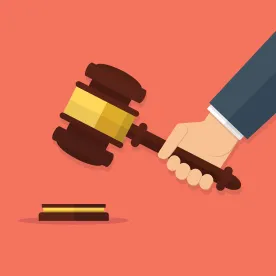The United States Supreme Court this week unanimously held that the five-year statute of limitations established in 28 U.S.C. §2462 applies to disgorgement in Securities and Exchange Commission (SEC) enforcement proceedings. The Court in Charles Kokesh v. Securities and Exchange Commission concluded that the SEC’s use of disgorgement amounts to a penalty and thus is subject to the five year statute of limitations.[1] The decision in Kokesh represents a further practical limitation on the SEC’s remedial power and could have implications for other agency actions, including the Federal Energy Regulatory Commission (FERC) and the Commodity Futures Trading Commission (CFTC).
Kokesh presented the question of whether the five-year statute of limitations that limits the jurisdiction of federal courts in any “action, suit or proceeding for the enforcement of any civil fine, penalty, or forfeiture, pecuniary or otherwise,” applies in SEC disgorgement claims. This decision is the most recent in a line of cases in which the Supreme Court has imposed limits on the SEC’s ability to reach individuals for violations of federal securities laws. For example, in Gabelli v. SEC,[2] the Court held that the statute of limitations for SEC actions for civil monetary penalties begins to run when the fraud occurs (“standard rule”) rather than when discovered (“discovery rule”). The Court declined to apply the “discovery rule” on the reasoning that the central mission of the SEC is to investigate violations of securities laws, therefore no additional leniency is needed. The Court noted the contrast to instances where a private plaintiff may not know they have been defrauded and the application of the “discovery rule” would operate to preserve their claim. In Gabelli, the Court cited Chief Justice Marshall’s reasoning for limits on penalty actions: “it would be utterly repugnant to the genius of our laws if actions for penalties could be brought at any distance of time.”
The Court in Kokesh concluded that SEC disgorgement is a penalty subject to the §2462 statute of limitations based on three key factors:
1. The Court reasoned that the punishment was imposed as a consequence of violating “public laws” and is done in the public interest, as opposed to being done on behalf of the injured parties.
2. The Court determined that the SEC seeks disgorgement to deter future wrongdoing, which is an inherently punitive goal.
3. The Court observed that the disgorged funds are not compensatory because they are paid to the district court which has the discretion to determine how the funds will be distributed. While victims may receive some funds, there is no statutory requirement to that effect and some funds will end up in the United States Treasury.
Taken together, the Court found that disgorgement, “bears all the hallmarks of a penalty” and thus the five-year statute of limitations found in §2462 applies to SEC disgorgement proceedings.
The Court rejected the SEC’s argument that the use of “penalty” in §2462 should be construed as a “punishment” and disgorgement in SEC actions is not a penalty because it simply returns the defendant to the status quo. Instead, the Court observed that the profits from a proceeding can exceed the loss caused by the violation. The Court cited insider trading cases, which have subjected the tipper to disgorgement of the profits of third-parties who profited from the information even though the tipper never realized those profits. Additionally, the Court noted that disgorgement can be ordered without consideration of the cost of remedial actions taken by the defendant to mitigate the amount of illegal profit. In these cases the Court observes that this “leaves the defendant worse off” because they are unable to recover these costs in the disgorgement calculation.
The Court expressly limited its holding in this case to SEC enforcement proceedings, but the same factors likely will be applied when considering disgorgement by other federal agencies, including FERC and the CFTC.
FERC
If we apply the Kokesh analysis to FERC disgorgement actions, we get mixed results. First, FERC disgorgements are imposed for violations of “public law.” However, unlike the Securities and Exchange Act, there is no private right of action under FERC’s authorizing statutes. Therefore, FERC might argue that it is “standing in the shoes of” the injured parties such that the remedy is no longer sought on behalf of the United States, but is instead sought for a private party.
The second element of the Court’s reasoning (disgorgement as a deterrent) could equally apply to FERC. Courts have found that FERC disgorgement orders are not penalties, but they often have cited SEC precedent in support of that conclusion. That said, the SEC precedent used to justify this conclusion has arguably been overturned by Kokesh.
The final criteria considered in Kokesh (the non-compensatory nature of the payments) varies, but disgorgement ordered by FERC, unlike the SEC, historically has not found its way to the U.S. Treasury. Although disgorgement routinely is paid directly to those allegedly harmed, it also has been ordered to be paid to charities, whose beneficiaries may or may not have been harmed. For example, FERC most recently directed BP to disgorge $207,169 in profits by payment to the Texas Low Income Home Energy Assistance Program in order to benefit the impacted customers.
CFTC
The application of the same criteria to CFTC disgorgement actions also leaves the question open, but for different reasons. First, similar to the Securities Exchange Act, the Commodity Exchange Act provides for a private right of action, which would lend credence to the idea that the CFTC is enforcing a “public law” on behalf of the government rather than a private party, as the Court found in Kokesh.
Second, as to CFTC disgorgement acting as a deterrent, the Seventh Circuit has indicated that disgorgement does not penalize, but it did so by reference to the SEC precedent arguably overturned by Kokesh, as noted above. Finally, the proceeds of CFTC disgorgements have been distributed in a variety of ways. For example, funds have been used to first offset the cost of customer protection programs with any remaining funds to be placed in a trust to assist customers, firms and members that may have been harmed by the practices of the defendant. Other orders have given a CFTC monitor discretion as to how to distribute the funds. This includes the option that if the amounts to be paid are de minimis they may be treated as a civil monetary penalty and deposited in the United States Treasury. At a minimum, these discretionary practices are arguably like the SEC’s treatment of disgorged funds and likely fall short of the compensatory intent required in Kokesh.
Ultimately, the impact of Kokesh on FERC and CFTC disgorgement actions likely will be the subject of litigation. In the meantime, the decision should influence how parties and the agencies approach disgorgement in the future, including how the commissions articulate the purpose of disgorgement and to whom the disgorgement is paid.
Josh Robichaud contributed to this post.
[1] 581 U.S. ____ (2017).
[2]133 S. Ct. 1216 (2013)





 />i
/>i

